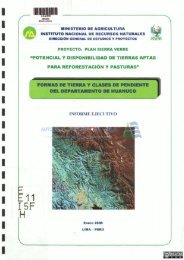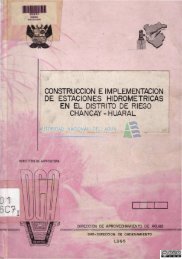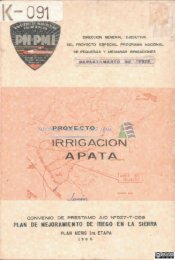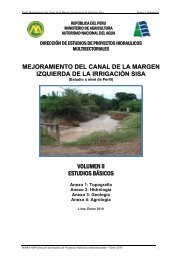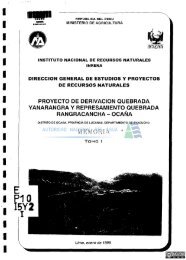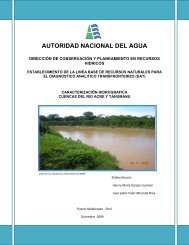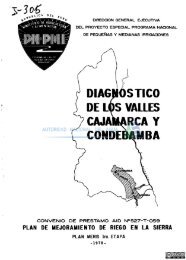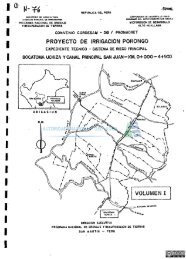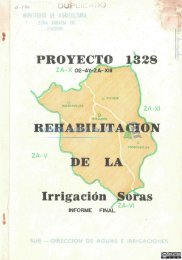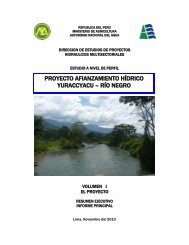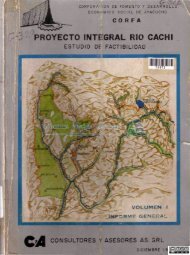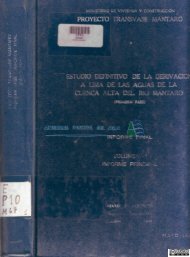^ ^ Pob<strong>la</strong>ción "^-v. Sectores Espacie ^s,.^ \ ^ Vacunos Vacas Terneras Terneros Toros Caprinos Ovinos Porcinos Aves Equinos Total Valor porcentual Fuente: CENAGRO Pob<strong>la</strong>ción CUADRO N 0 4-DA V.MC R ESTIMADO DE LA POBLACIÓN PECUARIA POR SECTORES Sector 1 N 0 cabeza ¡Miles S/. 4,940 2,640 1,110 740 450 45,820 1,220 8,300 14,500 5,060 — - 1972 51,220 31,680 7,770 5,920 5,850 22,910 610 5,395 2,175 6,072 88,382 17.0 Valor % 57.9 35.8 8.8 ', 6.7 6.6 25.9 0.7 6.1 2.5 6.9 100.0 C JNERN - 1° 77 (1976- 1977) Pob<strong>la</strong>ción Sector II N 0 cabezas Miles S/. 40,030 18,720 8,920 6,700 5,690 44,030 36,680 26,130 94,000 23,910 — 348,990 189,410 54,080 47,200 58,300 I7,: , .r'' 14,746 13,468 11,738 24,472 431,229 83.0 Valor % 81.0 43.9 12.6 11.0 13.5 !-.l 3.4 3.1 2.7 5.7 100.0 Pob<strong>la</strong>ción N 0 cabezas 44,970 21,360 10,030 7,440 6,140 89,850 37,900 34,430 109,000 28,970 __ Total Valor Miles <strong>de</strong> S/. 400,210 221,090 61,850 53,120 64,150 40,725 15,356 18,863 13,913 30,544 519,611 100.0 % 77.0 42.6 11.9 10.2 12.3 7.8 3.0 3.6 2.7 5.9 100.0 a > o z o en H n o > O n c TO L O T5 era ^ &
Pág. 446 CUENCA DEL RIO QUIROZ Y MARGEN IZQUIERDA DEL RIO MACARA 1 . Agríco<strong>la</strong> CUADRO N 0 5-DA VOLUMEN Y VALOR TOTAL DE LA PRODUCCIÓN AGROPECUARIA Actividad Alimenticios Industriales Pastos y forrajes 2„ Pecuario Carne Leche Lana Total Fuente: ONERN. Area Anual <strong>de</strong> .Producción 'Ha. % 16,135 12,540 2,755 840 __ 16,135 (1976- T977 ) 100.0 77.7 17.1 5.2 — - __ 100.0 TM 79,360 29,008 25,152 25,200 Volumen 6,694 3,706 2,980 8 86,054 -%--- 92.2 33.7 29.2 29.3 7.8 4.3 3.5 0.0 100.0 Valor MiJesy. 273,833 199,883 66,390 7,560 299,987 244,260 55,015 712 573,820 % 47.7 34.8 11.6 1.3 52.3 42.6 9.6 0.1 100.0 cultivables, <strong>la</strong>s <strong>de</strong> protección, <strong>la</strong>s <strong>de</strong> bosques y <strong>la</strong>s áreas <strong>de</strong> pastos <strong>naturales</strong> perma - nentes; en estas últimas, <strong>la</strong> vegetación es eminentemente graminal <strong>de</strong> tipo forrajero» En este grupo, se ubican también <strong>la</strong>s áreas <strong>de</strong> pastos cultivados y <strong>la</strong>s áreas sin culti — vos o empastadas, conocidas como " invernas "; asimismo, constituyen áreas <strong>de</strong> uso pecuario eventual <strong>la</strong>s superficies cultivadas que en época <strong>de</strong> cosecha <strong>de</strong>jan rastrojos y broza, <strong>la</strong>s que son aprovechadas por el ganado. (2). Tenencia En <strong>la</strong> zona <strong>de</strong> estudio, <strong>la</strong> tenencia <strong>de</strong> <strong>la</strong> tierra guarda re<strong>la</strong>ción con el régimen <strong>de</strong> conducción <strong>de</strong> <strong>la</strong>s unida<strong>de</strong>s agropecuarias. Según el Censo Nacional Agropecuario (CENAGRO) <strong>de</strong> 1972, se ha podido i<strong>de</strong>ntificar dos modalida<strong>de</strong>s: simples y mixtas. En <strong>la</strong>s formas simples, <strong>la</strong>s unida<strong>de</strong>s agropecuarias se encuentran bajo un solo régimen <strong>de</strong> tenencia, en el cual se involucra a <strong>los</strong> propietarios, a modo <strong>de</strong> propietarios, adju dicatarios, ocupantes precarios, arrendatarios, feudatarios, comuneros y otros. Las formas mixtas son catalogadas como tales cuando más <strong>de</strong>l 50% <strong>de</strong> <strong>la</strong> unidad agropecuaria es propiedad y <strong>la</strong> parte restante se encuentra bajo otras formas <strong>de</strong> tenencia. La información cuantificada por CENAGRO el año 1972, a pesar <strong>de</strong> que no cubrió el área total <strong>de</strong>l estudio, fue utilizada como medio <strong>de</strong> obtener <strong>la</strong> información más ac —
- Page 1 and 2: OFICINA NACIONAL DE EVALUACIÓN DE
- Page 3 and 4: fecha: •HP •iÜltvtM* . hh 'KV
- Page 5 and 6: Mapa N° 1 Fisiográfico, escala 1:
- Page 7 and 8: Pig. 434 CUENCA DEL RIO QUIROZ Y MA
- Page 9 and 10: 436 CUENCA DEL RIO QUIRDZ Y MARGEN
- Page 11 and 12: 438 CUENCA DEL RIO QUIROZ Y MARGEN
- Page 13 and 14: 440 CUENCA DEL RIO QUIROZ Y MARGEN
- Page 15 and 16: Pág. 442 CUENCA DEL RIO QUIROZ Y M
- Page 17: Pág. 444 CUENCA DEL RIO QUIROZ Y M
- Page 21 and 22: Regímenes A. Formas Simples 1 . Pr
- Page 23 and 24: Sub-estrato Menos de 3.0 De 3.1 a 1
- Page 25 and 26: Cultivo Yuca Arroz Mafz Café Caña
- Page 27 and 28: Pág. 454 CUENCA DEL RIO QUIROZ Y M
- Page 29 and 30: Cultivos Arroz Mafz Yuca Cereales T
- Page 31 and 32: i Cultivos Arroz Yuca Maíz Café C
- Page 33 and 34: Pág. 460 CUENCA DEL RIO QUIROZ Y M
- Page 35 and 36: Cultivos Cafe Yuca Caña de azúcar
- Page 37 and 38: Pág. 464 CUEÍC A DEL RIO QUIROZ Y
- Page 39 and 40: 466 CUENCA DEL RIO QUIROZ Y MARGEN
- Page 41 and 42: Pág. 468 CUENCA DEL RIO QUIROZ Y M
- Page 43 and 44: Pág. 470 CUENCA DEL RIO QUIROZ Y M
- Page 45 and 46: Pág. 472 CUENCA DEL RIO QUIROZ Y M
- Page 47 and 48: Prestatario y Clase de Préstamo Em
- Page 49 and 50: 476 CUENCA DEL RIO QUIROZ Y MARGEN
- Page 51 and 52: Pág. 478 CUENCA DEL RIO QUIROZ Y M
- Page 53 and 54: Pág. 480 CUENCA DEL RIO QUIROZ Y M
- Page 55 and 56: Pág. 482 CUENCA DEL RIO QUIROZ Y M
- Page 57 and 58: Pág. 484 CUENCA DEL RIO QUIROZ Y M
- Page 59 and 60: Pá g- 486 CUENCA DEL RIO 0U1RD2 Y
- Page 61 and 62: Pág. 488 CUENCA DEL RIO QUIROZ Y M
- Page 63 and 64: v Sectores y >sDistritos x. Product
- Page 65 and 66: Pág. 492 CUENCA DEL RIO QUIROZ Y M
- Page 67 and 68: Pág. 494 CUENCA DEL RIO QUIROZ Y M
- Page 69 and 70:
Pág. 496 CUENCA DEL RIO QUIROZ Y M
- Page 71 and 72:
Especie Vacunos Porcinos Caprinos O
- Page 73 and 74:
500 CUENCA DEL RIO QUIROZ Y MARGEN
- Page 75 and 76:
Pág. 502 CUENCA DEL RIO QUIROZ Y M
- Page 77 and 78:
Pág. 504 CUENCA DEL RIO QUIROZ Y M
- Page 79 and 80:
Clasificación CUENCA DEL RIO QUIRO
- Page 81 and 82:
508 CUENCA DEL RIO QU1ROZ Y MARGEN
- Page 83 and 84:
510 CUENCA DEL RIO QUIROZ Y MARGEN
- Page 85 and 86:
Pág. 512 CUENCA DEL RIO QUIROZ Y M
- Page 87 and 88:
Pág. 514 CUENCA DEL RIO QUIROZ Y M
- Page 89 and 90:
Comercio Fronterizo Registrado CUEN
- Page 91 and 92:
Pág. 518 CUENCA DEL RIO QUIROZ Y M
- Page 93 and 94:
Pág. 520 CUENCA DEL RIO QUIROZ Y M
- Page 95 and 96:
Actividad | Industria de Alimentos
- Page 97 and 98:
Pág. 524 CUENCA DEL RIO QUIRDZ Y M
- Page 99 and 100:
Pág. 526 CUENCA DEL RIO QUIROZ Y M
- Page 101 and 102:
Pág. 528 CUENCA DEL RIO QUIROZ Y M
- Page 103 and 104:
Pág. 530 CUENCA DEL RIO QUIROZ Y M
- Page 105 and 106:
Pág. 532 CUENCA DEL RIO QUIROZ Y M
- Page 107 and 108:
ANEXOS
- Page 109 and 110:
CUADRO N° ! POBLACIÓN ECONÓMICAM
- Page 111 and 112:
CUADRO N 0 3 NUMERO Y TASA POR DIEZ
- Page 113 and 114:
Establecimiento Centro de Sal ud Po
- Page 115 and 116:
-—^^^ Distritos - « ^ ^ ^ Tipo d
- Page 117 and 118:
N. Distribución por >. Tipo de \Vi
- Page 119 and 120:
Pág. 12 CUENCA DEL RIO QUIROZ Y MA
- Page 121 and 122:
ANEXO II - GEOLOGÍA Pág. 15 ANEXO
- Page 123 and 124:
ANEXO 11 - GEOLOGÍA Pág. 17 Cuarz
- Page 125 and 126:
MÍCROFOTOGRAFIA N° 1 (muestra N"
- Page 127 and 128:
ANEXO II - GEOLOGÍA Pág. 19 b) Mi
- Page 129 and 130:
ANEXO II - GEOLOGÍA Pág. 21 Const
- Page 131 and 132:
ANEXO II - GEOLOGÍA Pág. 23 zaci
- Page 133 and 134:
ANEXO II - GEOLOGÍA III. ANÁLISIS
- Page 135 and 136:
Pág. 28 CUENCAJDEL RIO QUIROZ Y MA
- Page 137 and 138:
Pág. 30 CUENCA DFL TIO nmo? '•'
- Page 139 and 140:
pá 32 CUENCÜ DEL RIO OUIROZ Y MAR
- Page 141 and 142:
Pág. 34 Precipitación Temperatura
- Page 143 and 144:
Pág. 36 Zona Correlación con FAO
- Page 145 and 146:
PSg. 38 CU MC.CT) 'L "JO )uiic: izp
- Page 147 and 148:
Pág. 40 Temperatura Zona de vida M
- Page 149 and 150:
Pág. 42 CUENCA DHL RIO Qll'lUZ N'
- Page 151 and 152:
Pág. 44 (B) 35 - 50 CR 50 + 110 Zo
- Page 153 and 154:
Pág. 46 CUCNCA'DilL n JO QUI ÍP .
- Page 155 and 156:
Pág. 48 Zona Correlación con FAO
- Page 157 and 158:
Pág, 50 Material madre Vegetación
- Page 159 and 160:
Pág„ 52 CUENCA DEL RIO QUIROZ Y
- Page 161 and 162:
| OASFICACION NAIUtAL | SOU lAXONOM
- Page 163 and 164:
I OASBCACION NAIWAl SOIIAXOHOMY Hop
- Page 165 and 166:
I . OASIHCAUON NATURAL 1 SOIL TAXON
- Page 167 and 168:
Pág. 62 CUENCA DEL RIO QUIROZ Y MA
- Page 169 and 170:
64 CUENCA D":L RIO QUIROZ Y MARGEN
- Page 171 and 172:
66 CUENCA DEL RIO QUIROZ Y MARGEN I
- Page 173 and 174:
Pág. 68 16c Perico ( Brotogeris sp
- Page 175 and 176:
Píg. 70 CUENCA DEL RIO QUIROZ Y MA
- Page 177 and 178:
CUADRO NT 3 DESCARGAS MEDIAS MENSUA
- Page 179 and 180:
(Continuación) Año 1960 1961 1962
- Page 181 and 182:
Muestra Ubicación CUENCA DEL RIO Q
- Page 183 and 184:
Cuenca QMroz Macará Distrito Ayaba
- Page 185 and 186:
Distrito Ayabaca Ayabaca Ayabaca Mo
- Page 187 and 188:
Mes Ene. Feb. Mar. Abr. May. Jun. J
- Page 189 and 190:
Cultivo Arroz Yuca Pastos Caña Fru
- Page 191 and 192:
Cultivo Caña Plátano-café Pláta
- Page 193 and 194:
Cultivo Caña Plátano Yuca Frutale
- Page 195 and 196:
•[MM IIIHIUI mi mi = - _ = | _ E
- Page 197 and 198:
.i=l 11 -,,, II! ENVOLVENTE PROBABI
- Page 199 and 200:
Pig. 94 CUENCA DEL RIO QUIROZ Y MAR
- Page 201 and 202:
96 CUENCA DEL RIO QUIROZ Y MARGEN I
- Page 203 and 204:
\ o T3 3 O U 30 40 50 ÍO 70 Duraci
- Page 205 and 206:
RECTÁNGULO EQUIVALENTE DE LA CUENC
- Page 207 and 208:
REUCION LONGITUD -AREA DE LA CUENCA
- Page 209 and 210:
je. MES ENERO FEBRERO MARZO ABRIL M
- Page 211 and 212:
Cultivos 1 Industriales Caña de az
- Page 213 and 214:
Cultivos Yuca Maíz Arroz Café Ca
- Page 215 and 216:
Cultivos Arroz Yuca Maíz Hortaliza
- Page 217 and 218:
Arroz Yuca Mafz Cultivos Plátano C
- Page 219 and 220:
pá g. 114 CUENCA DEL RIO QUIROZ Y
- Page 221 and 222:
Impreso Oficina Nacional de Evaluac
- Page 223 and 224:
•«m^zmmi? •». " ^>*
- Page 225 and 226:
MAPA Ho. 2 -f
- Page 227:
is; ! ¡i i i 1 1 11 3g ENSUSL '~n
- Page 230 and 231:
DISTRIBUCIÓN ECOLÓGICA DE LAS TIE
- Page 232 and 233:
GRUPOS Y ASOCIACIONES DE GRUPOS DE
- Page 234 and 235:
' SÍMBOLO A m í^s.l 0 ~íl • mi
- Page 236 and 237:
--/ "Zi J\ \ ZONAS DE MAYOR SUSCEPT
- Page 239 and 240:
MAPA N«. 9 jb—»~
- Page 241 and 242:
*- -A
- Page 243 and 244:
•4 MAPA No. 1|
- Page 245:
m ws,, Míiii«Bi**"***^ h o 2 —*
- Page 248:
- MAPA No, 1: F1SI0GRAFIC0 MAPA No.



